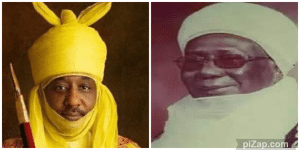
The deposition of Muhammadu Sanusi II as the 14th Emir of Kano in March 2020 by the Kano State Executive Council, led by former Governor Abdullahi Ganduje, marked a significant moment in the history of Nigeria’s traditional leadership.
Sanusi was removed from office due to allegations of insubordination and a lack of respect for Kano State’s laws and traditions.
However, Sanusi II’s ousting is not an isolated incident in the annals of Nigerian history.
Over the years, several high-profile monarchs have been deposed for various reasons. Notably, this incident mirrored a familial precedent, as Sanusi II’s grandfather, Muhammadu Sanusi I, was also deposed in 1963 under similar circumstances.
The repeated history highlights the complex relationship between traditional authority and political power in Nigeria, where traditional rulers often play significant roles in the social and political spheres but are also subject to the dynamics of political authority and governance.
Below is the list of five Northern monarchs that have been deposed in Nigeria:
1. Muhammadu Sanusi I: Sanusi I became the 11th emir of Kano after Abdullahi Bayero passed away on December 23, 1953. Prior to becoming emir, Sanusi was a senior councilor in the emirate council, where he held significant influence over its administration for over ten years.
Reports from the palace suggest that the late emir had a good relationship with the emerging Western-educated elite, helping them integrate into the native authority’s services. His appointment as emir brought about major changes in the state’s elite circles. However, disagreements arose when some senior NPC members in Kaduna became concerned about his influence.
This led to the formation of a commission to investigate the finances of the Kano native authority during Sanusi’s tenure. Chaired by D. J. M. Muffet, the commission heard testimonies from authority members and ultimately recommended that the emir resign.
Following this recommendation, the regional government asked for Sanusi I’s resignation, which he promptly submitted to Kashim Ibrahim, the governor of the northern region, on March 28, 1963.
2. Mustapha Jokolo: In June 2005, the state government removed Mustapha Jokolo from his position as the 19th emir of Gwandu, a town and emirate in Kebbi State.
This was due to allegations that he had made statements considered reckless and potentially harmful to national security. There were also reports of strained relationships between Jokolo and other traditional rulers in the state, as well as claims that he had neglected his duties and moved to Kaduna with his family.
Mohammed Ambursa, who was the commissioner of information in Kebbi at the time, announced that Adamu Aliero, the governor of the state, used his authority under the chiefs (appointment and deposition) law to depose the emir. Shortly after Jokolo was removed, a new emir was appointed by the state.
However, almost nine years later, in 2014, a Kebbi state high court ordered Jokolo reinstated, overturning his previous removal.
3. Ibrahim Dasuki: On April 20, 1996, Ibrahim Dasuki, after an eight-year reign, was removed from his position as the sultan of Sokoto. He was said to have been dethroned on the orders of Sani Abacha.
Dasuki was called to Yakubu Muazu’s office, the military administrator of Sokoto at the time, and was informed of his dethronement.
He was then taken to Yola and later to Jalingo in Taraba state, where he was put into exile. Muazu mentioned that Dasuki’s removal was due to actions that allegedly caused tension among the people and within the royal family, as well as a perceived disregard for government directives.
4. Umaru Tukur: The Emir of Muri faced a similar fate as other traditional rulers in the North when he was deposed due to perceived defiance towards the state governor.
Umaru Tukur assumed the position of 11th emir of Muri in 1966. However, after two decades of his reign, tensions arose between him and Yohana Madaki, the governor of Gongola state at the time.
Their ongoing conflicts ultimately led to Tukur’s removal from his position. On August 12, 1986, Governor Madaki issued an official decree stripping Tukur of his title as emir and chairman of the Muri emirate council. Madaki levelled allegations of misconduct within the palace against the deposed emir.
Subsequently, in September 1986, Madaki issued another order banishing Tukur to Mubi in what is now part of Adamawa State.
Following the division of Gongola State in 1991, the territories were split into Adamawa and Taraba States.
5. Muhammed Sanusi II: He was deposed for showing “insubordination” to the authorities in the northern state of Kano.
Sanusi II, an ex-central bank chief, has had frosty relations with Kano Governor Abdullahi Ganduje since 2017.
Since the emir and governor fell out, Mr Sanusi has not attended state functions and official meetings, which the government said amounted to “total insubordination”.
The emir’s refusal to appear before a panel investigating allegations of corruption against him also did not go down well with the government.
However, the present Kano State Governor, Abba Yusuf, officially reinstated HRH Muhammadu Sanusi II as the Emir of Kano State, on May 24, 2024.
The post List Of Northern Monarchs Deposed In Nigeria appeared first on Naija News.


